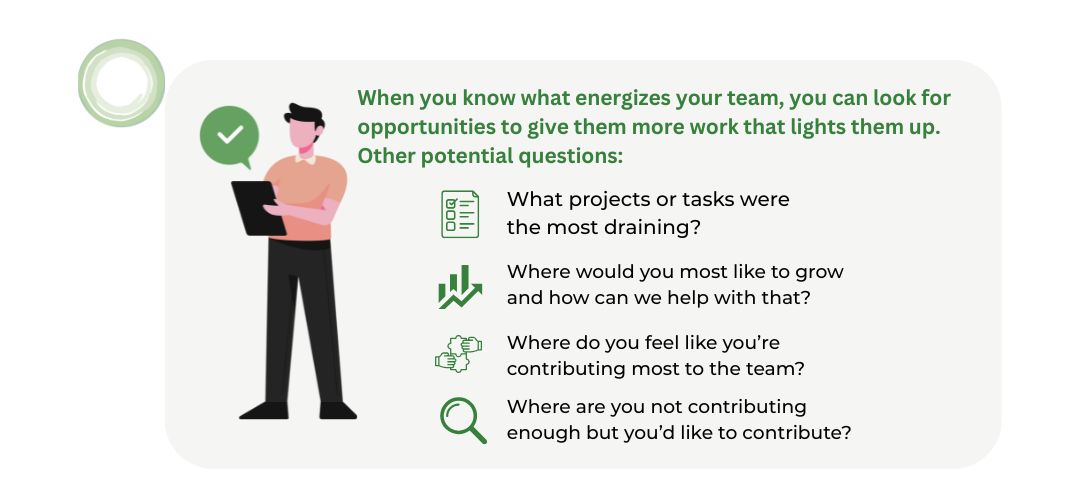Would you be offended if I said there is a good chance you don’t know what motivates your employees?
It’s not personal! In fact, most leaders misjudge how to keep their employees engaged at work. It seems like many employees would be motivated by higher pay or more vacation time, right?

Surprisingly, a Gallup poll shows that — more than money — people are motivated by development opportunities. 87% of millennials say development is important to them, and of that group, two-thirds say it’s extremely important. Another Gallup poll states that people are more likely to leave a job if they feel their unique strengths aren’t being recognized.
Want to help your team uncover and apply their unique strengths? Try our Enneagram Applied program to unlock deeper motivation and engagement across your team.
So how do we figure out what motivates our particular team members?
Like most things, it starts with a conversation. Few leaders have ever had an honest, direct and open conversation with team members about motivation. There’s a yearly review mostly focused on past performance and that’s about it.
Need support guiding those conversations? Our executive coaching and leadership training includes frameworks that help leaders uncover what truly drives team members.
We can do better! Use the beginning of each quarter as a reason to engage in these grounding conversations. If you’re not sure how to open that door, start by getting honest feedback from your team. Create the expectation with your team that you will do this more than once a year and together take action on the information they share with you.
Ask your team members: “What project gave you the most energy last quarter?” or “What had you feel most engaged at work over the past few months?”
As strange as it sounds, directly asking your team members “What motivates you?” probably won’t result in the answer you’re looking for. Humans are notoriously bad at understanding or communicating what motivates them. And even if they do know, they may be hesitant to share that information with their boss.
So instead of asking them a question they probably can’t or won’t answer, try asking them about the projects that energized them. Did they get energy from facilitating meetings? Negotiating contracts? Mentoring new hires?
When you know what energizes your team, you can look for opportunities to give them more work that lights them up.
Other potential questions:
- “What projects or tasks were the most draining?”
- “Where would you most like to grow and how can we help with that?”
- “Where do you feel like you’re contributing most to the team?”
- “Where are you not contributing enough but you’d like to contribute?”

Add motivating aspects to less exciting projects
Not every project can be a dream project. But once you know what energizes and motivates your team, you can tuck some of those “fun” tasks into each project.
If you know that Jess loves facilitating or presenting, make sure she leads sharing the findings of the less-than-super-fun project to the client. If you know that Chris thrives when he’s leading newer team members, put him in charge of project managing the new hires for that somewhat-boring project.
And when you do this — when you add these energizing, motivating tasks to someone’s plate — make sure they know you did that on purpose. This can be as easy as saying “Jess, I know you mentioned that you really like facilitating, so I thought maybe you could present to the client.” When our team knows we’re listening to their needs and trying to meet them, morale and productivity goes up.
Ready to create high-performing, deeply motivated teams? Explore our High-Performing Teams framework to equip your leaders with the tools to motivate from within.
Check in at the end of the quarter
After your team has spent three months doing more of the work that energizes and motivates them, check in again. How do they feel now? Do they feel energized? Empowered? Do they feel like they’ve expanded their skill set?
And ask them that same set of questions you asked at the beginning of the quarter. Work together to create a plan that will help them continue to learn, grow and excel within your company.
Motivation is a slippery thing. It varies from person to person and it changes over time. While it requires a bit of extra work to check in with each team member and tweak projects to fit motivations, it’s an approach that will pay off in better results and more engaged teams.
Want deeper support in engaging and motivating your team members? Help is a click away.


